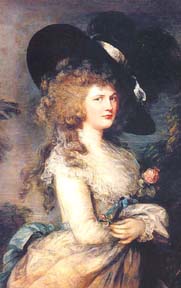

 |
Biography |
I am happy that you are using this web site and hope that you found it useful. Unfortunately, the cost of making this material freely available is increasing, so if you have found the site useful and would like to contribute towards its continuation, I would greatly appreciate it. Click the button to go to Paypal and make a donation.
This article was written by Thomas Finlayson Henderson and was published in 1886
 Georgiana, Duchess of Devonshire, eldest daughter of John, first earl Spencer, was born 9 June 1757. She married in June 1774 the fifth duke of Devonshire, who was regarded as the ‘first match’ in England, and his wife became the reigning queen of society. She set the fashion in dress, and introduced a simple and graceful style to supersede the ridiculous hoop. But though entering with great zest into the fashionable amusements of the time, she possessed intellectual and moral characteristics of a kind which entitles her to be classed above the ordinary women of fashion.
Georgiana, Duchess of Devonshire, eldest daughter of John, first earl Spencer, was born 9 June 1757. She married in June 1774 the fifth duke of Devonshire, who was regarded as the ‘first match’ in England, and his wife became the reigning queen of society. She set the fashion in dress, and introduced a simple and graceful style to supersede the ridiculous hoop. But though entering with great zest into the fashionable amusements of the time, she possessed intellectual and moral characteristics of a kind which entitles her to be classed above the ordinary women of fashion.
Great as were her personal charms, they were not the chief source of her influence even over the majority of her admirers; ‘it lay in the amenity and graces of her deportment, in her irresistible manners, and the seduction of her society’ (Wraxall). Walpole writes of her, she ‘effaces all without being a beauty; but her youthful figure, flowing good nature, sense and lively modesty, and modest familiarity make her a phenomenon’. Madame d'Arblay when she met her did not find so much beauty as she expected, but ‘far more of manner, politeness, and gentle quiet’. She delighted in the society of persons of talent, and numbered among her special friends Fox, Sheridan, and Selwyn. Wraxall records that he has ‘seen the Duchess of Devonshire, then in the first bloom of youth, hanging on the sentences that fell from Johnson's lips, and contending for the nearest place to his chair’. Johnson when seventy-five visited the duke and duchess in 1784 at Chatsworth, and was, he mentions, ‘kindly received and honestly pressed to stay,’ but on account of his bodily infirmities declined to prolong his visit. The Duchess of Devonshire was very strongly opposed to the political party in power, and, notwithstanding ‘the endeavours of the court party to deter her by the most illiberal and indecent abuse’, devoted her utmost efforts to secure the return of Fox at the famous Westminster election of 1784. During her canvass she entered ‘some of the most blackguard houses in the Long Acre’; though very ‘coarsely received by some worse than tars’, she was not in the least daunted, and is said to have exchanged kisses for promises of votes. She died at Devonshire House, Piccadilly, 30 March 1806, and was buried in the family vault at St. Stephen's Church, Derby. She left a son and two daughters. She also left an illegitimate daughter, brought up by the child's father, Charles Grey, with whom the duchess had a very public affair.
The duchess wrote verse, some of which displays very apt and elegant expression, while the sentiment also rises above the commonplace. Walpole refers to a number of poems circulating in manuscript, written by her while a girl to her father, and mentions also having seen an ‘Ode to Hope’ by her, ‘easy and prettily expressed, though it does not express much,’ and ‘Hope's Answer’ by the Rev. William Mason, of which he entertained a much higher opinion. A poem by her on the ‘Passage of the Mountain of St. Gothard,’ dedicated to her children, was published with a French translation by the Abbé de Lille in 1802; an Italian translation by Signor Polidori appeared in 1803; a German translation in 1805; and in 1816 it was reprinted by the duke's long term mistress in a 'menage a trois' and subsequently his second wife, Elizabeth, along with a ‘Journey through Switzerland,’ originally published in 1796. It gave occasion to the ode of Coleridge with the refrain—
O lady, nursed in pomp and pleasure,
Whence learned you that heroic measure?
| Meet the web creator | These materials may be freely used for
non-commercial purposes in accordance with applicable statutory allowances
and distribution to students. |
Last modified
12 January, 2016
|